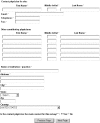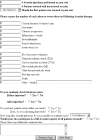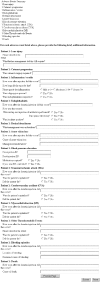The International Intravitreal Bevacizumab Safety Survey: using the internet to assess drug safety worldwide
- PMID: 16854824
- PMCID: PMC1857484
- DOI: 10.1136/bjo.2006.099598
The International Intravitreal Bevacizumab Safety Survey: using the internet to assess drug safety worldwide
Abstract
Aim: Off-label intravitreal injections of bevacizumab (Avastin) have been given for the treatment of neovascular and exudative ocular diseases since May 2005. Since then, the use of intravitreal bevacizumab has spread worldwide, but the drug-related adverse events associated with its use have been reported only in a few retrospective reviews. The International Intravitreal Bevacizumab Safety Survey was initiated to gather timely information regarding adverse events from doctors around the world via the internet.
Methods: An internet-based survey was designed to identify adverse events associated with intravitreal bevacizumab treatment. The survey web address was disseminated to the international vitreoretinal community via email. Rates of adverse events were calculated from participant responses.
Results: 70 centres from 12 countries reported on 7113 injections given to 5228 patients. Doctor-reported adverse events included corneal abrasion, lens injury, endophthalmitis, retinal detachment, inflammation or uveitis, cataract progression, acute vision loss, central retinal artery occlusion, subretinal haemorrhage, retinal pigment epithelium tears, blood pressure elevation, transient ischaemic attack, cerebrovascular accident and death. None of the adverse event rates exceeded 0.21%.
Conclusion: Intravitreal bevacizumab is being used globally for ocular diseases. Self-reporting of adverse events after intravitreal bevacizumab injections did not show an increased rate of potential drug-related ocular or systemic events. These short-term results suggest that intravitreal bevacizumab seems to be safe.
Conflict of interest statement
Competing interests: AEF and ER have participated in Genentech‐sponsored scientific advisory boards, for which they received honoraria and reimbursement for travel expenses. PJR has received clinical research support from Genentech and reimbursement of travel expenses and honoraria from Genentech for participation in scientific advisory boards.
Comment in
-
Is intravitreal bevacizumab (Avastin) safe?Br J Ophthalmol. 2006 Nov;90(11):1333-4. doi: 10.1136/bjo.2006.102293. Br J Ophthalmol. 2006. PMID: 17057166 Free PMC article.
-
The international intravitreal bevacizumab safety survey.Br J Ophthalmol. 2006 Nov;90(11):1440-1. Br J Ophthalmol. 2006. PMID: 17057183 Free PMC article. No abstract available.
References
-
- Rosenfeld P J, Fung A E, Puliafito C A. Optical coherence tomography findings after an intravitreal injection of bevacizumab (avastin) for macular edema from central retinal vein occlusion. Ophthalmic Surg Lasers Imaging 200536336–339. - PubMed
-
- Rosenfeld P J, Moshfeghi A A, Puliafito C A. Optical coherence tomography findings after an intravitreal injection of bevacizumab (avastin) for neovascular age‐related macular degeneration. Ophthalmic Surg Lasers Imaging 200536331–335. - PubMed
Publication types
MeSH terms
Substances
LinkOut - more resources
Full Text Sources
Other Literature Sources
Medical



